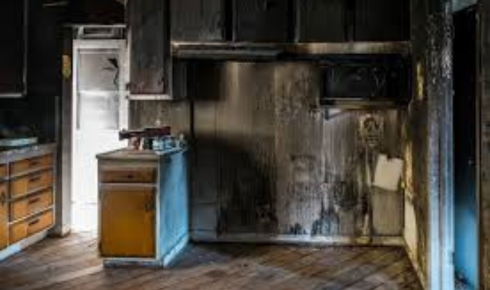After a fire, most homeowners notice the obvious damage first. Black marks on the walls, cracked windows, and burnt flooring all grab attention. But one area we often see overlooked until it’s too late is the kitchen cabinets. At CRBR, we’ve helped families across Chico, Sacramento, Redding, and Yuba City recover after kitchen fires, and time and time again, the cabinets are the hardest part to save.
Unlike walls, which are flat and made of drywall, cabinets are made of materials that react differently to heat, smoke, and moisture. Many cabinets are made from particleboard, which is especially sensitive. During one project in Redding, we arrived after a stovetop fire had been put out. The walls were cleaned and sealed quickly. But the cabinets? They had absorbed smoke into every pore. The outer layer looked okay, but when we opened the doors, the smell of burnt plastic and food was strong. The smoke had soaked into the structure.
Cabinets often trap heat. In a Sacramento kitchen fire, a toaster caught fire while the homeowners were outside. The flames reached the upper cabinets before the fire department arrived. The walls behind the stove only had surface soot, but the cabinets above were warped, swollen, and smelled strongly of chemicals. That’s because heat rises fast and gets trapped in the box-like shape of cabinets. The smoke swirls inside, and with nowhere to escape, it soaks in deeply.
Even in small fires, the glue that holds cabinet parts together begins to weaken. In Chico, a minor fire from an oven left no visible burn marks, but weeks later, the cabinet doors began to sag. The bonding materials inside had been damaged by heat. Unlike drywall, which can be cleaned or replaced in sheets, cabinetry involves hinges, joints, paint or stain, and sealed finishes. Every part needs separate attention.
Smoke is oily and acidic. It doesn’t just leave a smell, it leaves behind sticky residue that discolors surfaces and seeps into gaps. In Yuba City, we were called for a fire damage cleanup after a deep fryer caught fire. The cabinets nearby had turned yellow from smoke, even though they weren’t directly burned. The smoke had gotten into the grooves, behind the handles, and even into the drawers. We had to remove the cabinets completely to get to the smoke damage cleanup behind them.
Water makes it worse. Firefighters spray large amounts of water to stop flames, and in the process, cabinets absorb that moisture. This leads to swelling, bubbling, and warping. We’ve seen this in homes across Sacramento, especially where kitchen sink overflow or appliance leak cleanup had already weakened wood before the fire. In one case, the lower cabinets had water from both the fire hose and a broken dishwasher line. That combination made the materials unsalvageable.
Odors from fire-damaged cabinets are also harder to remove than from walls. Drywall can be sealed with special paint. Cabinets made from wood or laminate, on the other hand, often need sanding, deodorizing, and sealing on every surface—including the backs. In one Chico home, the smell lingered in the drawers for weeks because the bottoms weren’t sealed, and smoke had settled underneath.
Cabinets also hide damage in the walls behind them. During a structural restoration job in Redding, we found that smoke had traveled through gaps between the cabinet and wall, leading to hidden damage in the framing. That damage didn’t show until the homeowner noticed discoloration near the baseboard months later.
Sometimes, fires near the kitchen lead to plumbing issues. In Sacramento, a plumbing overflow cleanup was required when melted plastic from a fire dripped onto the water line under the sink. The line cracked, causing a water pipe break that flooded the cabinet base. That turned the damage from smoke-only into a full water damage restoration job.
Fire damage in the kitchen may also affect nearby appliances and vents. In a recent job in Yuba City, heat from the fire damaged the hvac discharge line, which caused moisture to build up later. The cabinets, already weakened from smoke, absorbed this moisture and began to crumble. What started as smoke cleanup turned into a burst pipe damage cleanup job.
Cabinets close to the ceiling can also be damaged from above. Roof leaks or storm and wind damage cleanup often follow fires, especially when the roof is cut or damaged by firefighting teams. Water from storms can enter through those openings and soak into top cabinets. In a Chico home, rainwater entered the attic and leaked down the kitchen wall, creating water streaks inside the upper cabinets long after the fire.
In some cases, cabinets also trap sewage removal & cleanup odors when water from nearby bathrooms or laundry rooms mixes with soot and smoke. This strange mix of smells becomes impossible to clean with regular products and requires full deodorizing.
Many homeowners try to scrub cabinet surfaces with cleaners or repaint them after a fire, but the damage often returns. The smell, the discoloration, or the softening of the material shows up again. That’s why at CRBR, we inspect all cabinetry during any fire damage restoration call and use moisture meters and smoke testing to understand the full picture.
Cabinet restoration after a fire is a careful process. It takes more than cleaning the outside. It means checking every layer, every joint, and every space behind and under the cabinets. Whether it’s from a clogged drain overflow, main water line break, or smoke traveling through the house, our team treats cabinets like the complex structures they are.
At CRBR, we help homeowners across Northern California rebuild their kitchens and bathrooms with the care they deserve. If your cabinets smell smoky, feel soft, or look warped, don’t wait. Our trained team will find the real damage and fix it the right way, so your home looks and feels like it should again.

